Royal Paladin
- Brampton Booster
- Jul 17, 2012
- Comment
Woah there! This is a REALLY outdated post. For more current and accurate articles visit my main page.
The Holy Knights can take over the planet Cray by shear numbers, and being the favourite clan by the main character, there are lots of valuable (and not so valuable) support.
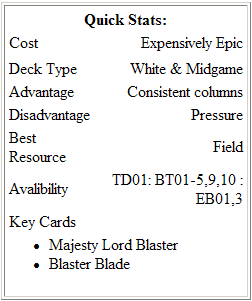
Unique Mechanic
Nearly every set contained RP, until Aichi decided to go to the Gold Paladin side(set 6). Nonetheless, they have a huge amount of support that gives them the edge. RP has only three things going for it:
Consistency, Power, Crit
Royal Paladin’s have various ways to bring out specific units, and so they can very easily bring out their Winning Image without waiting. But they are also very flexible,with various effects in all directions. The iconic figure of the clan is Blaster Blade, an on call ability to retire anything higher then a grade 2: even thuogh it is not Royal Paladin’s strength. There are more then 7 ways to bring this one unit out and 4 different supporters. This consistency falls on a lower level for most other cards, but you can appreciate the lengths RP’s can go to.
With all the fields it can create perfectly, the only object left out is power and crit. Almost all grade 3’s have either a power boost or a critical boost or even both.
Opinion
I’m not one to use a deck just because it’s a main, so I don’t use it. However, I realize that, even after a Barcgal ban, this deck is still a lean, mean killing machine. Most beginners play this deck horribly. You need to manage the field properly so you don’t have to replace any of your units with other ones. If your see an RP player replace one of their units, you see that as a terrible blunder.
They have no weakness other then having many of their effects having a high cost, therefore a fighter must consider if they have enough left over when they use an ability. Though my sidebar displays the main line of RP, many variants exist that don’t follow this guide. On the most part though, RP need damage to use many of their effects.
| Structure | |
|---|---|
| Advantages | Disadvantages |
|
|
| Resources | ||
|---|---|---|
| Deck | Hand | Drop |
| Due to RP’s great ability to call from the deck, you don’t need to worry about not drawing a certain card. This eliminates a lot of guesswork in a deck. Only thing is that you may run out of certain cards if you don’t play correctly. | Bring out units from your hand reduces the amount of cards you need to play, and so you also have a good hand. You might need to guard a pinch more against rearguards, but not too much to bring it below par. That makes Royal Paladin great even if the opponent blows up their field. | May the fallen warriors rest in piece. |
| Field | Damage | Soul |
| Perfect set-ups and Royal Paladin’s main advantage. If your opponent likes to retire or attack rearguards often, then you might have a problem here because then you have to bring out units normally or suffer from ruining your resources too early. But even with your mechanic trashed, you are just playing a normal power deck. Perfect set-ups is also an early game factor, as you must take care in all units placed. You have to ask yourself, do I need this 10 turns later when I have access to every card in my deck? Is there another, better card that can fulfill the same condition as what I’m using this unit for now? | I warn you not to take any more damage then what your Llew needs on your first turn. No need to use BB’s skill upfront since the game has progressed so little no advantage is gained at this point. This resource is both your best ally and your worst enemy. All of the good RP cards give you an immediate advantage; whether it adds one to your field or removes one of theirs. So while they are good, they aren’t spammable. Royal Paladin’s can play the damage game, taking in more damage then necessary to gain effects while conserving hand. | Other then the fascinating 18k Young Pegasus Knight from Llew, there are very few options. Soul Saver Dragon is a beast and it really churns out the maximum output of the soul. Lohengrin can provide nice rows to take advantage of. Galahad tries to use the soul, if not for being just slightly out of reach to be self-sufficient. |
| Game stages | ||
|---|---|---|
| Built as White, Middle game; designed for any situation | ||
| Entropy | ||
| -1 | -2 | -3 |
| Opening | Middle game | End game |
| Great early pressure, but mind you not to fill up the field so quickly. That’s why you have to replace units later on. And also don’t take so much damage. That way, you are off to a great damage lead. Or you can take slightly more damage, but make sure you can bite back. Already, you can mix up your playstyle here. That’s why Royal Paladin’s are good, they can adapt very easily. | Taking less damage in the beginning means you now you don’t need to guard as often, and with the calling abilities your hand is a huge reserve area. At this stage you are building towards your Winning Image and possibly may already have it, but even so you still have to flexibility to change your playstyle depending on what your opponent does. | Either two things are happening now, you have a shoddy field and a shoddy hand, or you have your perfect formation and a good hand. Thanks to your calling ability you now have to waste nothing more to add to your final formation. But on the same line, you actually can’t do anything anymore as you used all your counterblasts. Have you left anything unflipped, you might not have a chance to use it. |
| Pressure | Resistance |
|---|---|
| You have great early pressure, great mid-game pressure, great endgame pressure…ya good pressure all around. Just remember all your pressure is POWER pressure. So the only way to actually get somewhere is to pile on power. | If the opponent is a attack Vanguard only kind of player, you should win many games due to your good shield size. That said, having your rearguards attacked will draw out your guard, or lull a weaker unit to replace, and in both cases do not increase your damage to use effects. |
Staples & Cost
Heals are in TD01. The Grade 1 and 2 vanilla units are found in TD01. Perfect defenses are found in Set 1. The 13k attackers is found in TD01, but BT03 contains a better version. 12k attackers are only found in EB03.
Royal Paladins are crazy expensive. The perfect guards can be $35, $30 for Soul Savers, Blaster Blades and Alfreds. Really, it’s not a deck for beginners, even though it is found in a trial deck. I’m not even surprised when prices go double then what other clans have, due to the popularity.
Trigger Ratios
Criticals are more important then draws in an RP deck, as it is easier to bring out units and get advantage at the same time.
Crit and Power is the ONLY form of pressure Royal Paladins have, so it would make sense to have a 12CRIT/4HEAL by default.
TD01
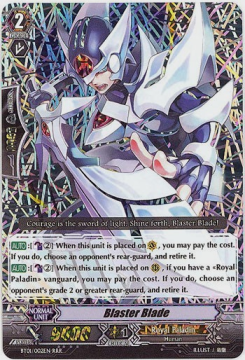
The godlike powers of Blaster Blade makes it the easiest, surefire way of getting rid of any troubling grade 3 or 2. And there are a lot. Don’t think removing a Grade 3 is okay, that is 1/8 of their powers gone. Right there. And you don’t have to worry about wasting an attack on a rearguard. Heck, in vanguard it truly removes anything. The other side of Blaster Blade is Beserk Dragon, which beats down Grade 2’s and lower. That’s fine, but Grade 3’s where the attacks are coming from. Berserk is also cloned to other clans, Blaster Blade is unique. His partner Wingal though is meh. (19k!? really? What are you trying to hit, Gancelot?)
Talking about Solitary Knight, Gancelot, it is a great card in bringing out Blaster Blade, an appalling card in the Vanguard circle. 9000 Power. Even with Blaster Blade in it’s soul to use it’s ability, that means you cut off a CB2 and a vanilla just for a 22k attack, or CB4 for 27k. But what does CB4 do? Throwing out perfect Defense, that means you wasted 4 damage to inflict three to your opponent. What a huge waste of counterblasts for a net loss. You didn’t bring out any support. You didn’t remove any powerful units your opponent has. You didn’t use any of the other, better options of Royal Paladins. Even if you manage to bring the almighty sword down on your foe it is probably because they were going to lose anyways to Alfred. So I don’t want to find that on a Vanguard Circle ever. It’s searching ability is quite nice, adding a Blaster Blade to your hand. No, it’s searching ability is astounding, giving you another opportunity to use the godly Blaster Blade. It can also be used for grade 3 checks, and a weaker but fun deck is to combine it with Bridgette. But it’s always going to be for searching Blaster Blade.
Knight of Conviction, Bors will be replaced by Set 3, but for now it gives great ability for RP to hit 20k and above. In fact, Royal Paladin is the only clan in Set 1 that can hit 20000 and over for every attack for a turn(using only a CB of 2).
The Main line of Royal Paladin’s don’t have Crimson Butterfly, Bridgette as it requires its own. There is this fun little deck that utilizes an insane number of Grade 3’s for the daring. Other then that, there are better options to look forward to in Set 1.
BT01
The start of Vanguard gave Royal Paladin a high footing with no glaring weakness. The sole competition is the rest of the big 4. OTT’s however lacked power, and Kagero was just playing the anti-everything game. Novas were the Paly’s equal, although it wasn’t used that much(oddly). So, Royal Paladins earned a great reputation with powerful units and easy style.

King of Knights, Alfred is the powerful leader and might be the most likely unit to go in every Royal Paladin deck. In vanguard it possess the ability to hit for 20000 every turn and although new sets have many 11ks it still is consistent and damages 10k LBers. Because Alfred is unable to be boosted, keeping the area below him empty gives him the ability to force at least a 10k shield out of every vanguard. Alfred also shows the first of RP’s weaknesses; RP is only as powerful as its Rearguards are.
However, his last ability allows us to generate a large field using few resources. Barcgal pumps out a new unit every turn and then we have Alfred’s ability. His ability work in both vanguard AND rearguard, and it’s ability is with a CounterBlast of 3, we can choose to bring out any GR2 or lower to our field. Anything giving us every key card we can ever hope to get from our deck. This makes him able to be put in any RP deck. Although CB3 is huge, it is worth it in many situations. Finally, Alfred is okay in Rearguard and can become a very useful back-up as we get everything together. This way we can have one main and count on Alfred as a back-up and Rearguard, swinging for good numbers against all vanguards even with an average field.
August 1st provided the first restricted card; a card that can’t be put as the First Vanguard(it can still be in the deck). Barcgal‘s ban was nothing to due with his effect, just some crazy Japanese people who love to main whatever the protagonist mains. For those who still think Barcgal is just overpowered, read the mechanics of this card. Barcgal is great for securing a grade 2 ride, therefore you can put in extra Grade 1’s and Grade 3’s for more power. As well, it get net you a bit of early pressure on the opponent if they don’t happen to be Kagero. But then again, if it was Kagero you are probably already to a bad start.
There are two decks to build here, With Set 1 Free Masons being the favourite. Seen only rarely, and only for fun with the Barcgal Ban, is the Double Butterfly.
BT02
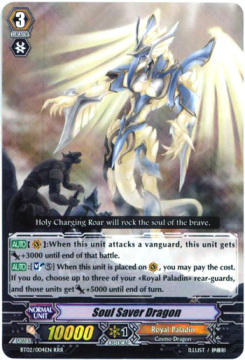
Boasting a 5000 boost to 3 units by removing unsued soul, it is no wonder Soul Saver Dragon is a cosmo dragon. While the developers planned to have this card to be a final turn option (as evidenced in the anime), Japanese players created a rushing beatdown strategy to drive the opponent out. Taking a bunch of early damage, then bite back and continue pressure was an effective strategy. Note though that the cost to pull this off was really high; Barcgal removed two triggers from the deck to equalize the large boost, and there were many ways to prevent the explosion of power from occurring. This card was still the beast in tournaments, as it takes nothing to give 26k attacks across the entire board. Set 2 also gave all the major clans support and allow Granblues to be functional, but RP had the best helpings. Just the same, SSD is placed into many RP decks for a final turn.
High Dog Breeder, Akane and Pongal really worked to give SSD it’s versatility. Pongal adds SSD and even with a Barcgal ban, it can still fill up all the necessary soul to use SSD for the late game. And it provides a useful 7k booster for the other units. Akane can bring out any Hi-beast, notably Pongal but also Wingal or Starlight. Even if you don’t have a SSD in your deck, you still get a great 7k plus. Akane however, is much better in later sets with more Hi-beasts to bring out.
Young Pegasus Knight will never get old as long as you get +12000 for riding a free Blaster Blade. Who will guard an 28k attack early game?(rhetorical question, don’t answer) But in honest truth, it’s really not that powerful. After you get over the overpowered boost from this one time chance (in which you might not even get a YPK before it) the other options, Pongal and Margal, don’t give enough consistency. It does have the uncanny ability to pair up with Lohengrin, but boosting for 9000 isn’t any different then 8000. If you want consistent power, go with Soul guiding Elf. Great sage Baron is worse; you can’t get the +12000 and you need to take out either BB(never), Gallatin(nope), Akane(hawt) and Gordon(better then Baron) for a situational +3k. So…no.
Margal kicks out Govanon. The other trigger, Little Fae, has a much better art then Flogal and since Barcgal was kicked we can add that in for pure aesthetics. Margal is a nice option, but 3k isn’t usually necessary to any unit if you play correctly.
Gigantic Charger is a nice addition to Royal Paladins field advantages. If you get something good, then it’s great. If not, you can trade it in for something better. You don’t lose much even if it is a Trigger. You can use him to fill out positions without committing too much, making him a great rearguard on the cheap. You can use RP’s effects to add a 7k or higher Rearguard behind him easily afterwards. But it isn’t as good as other RP in terms of power and consistency.
Set 2 Cosmic Paladins went all over in tournaments, to be solidified in Set 3. Soul paladins never were too popular, possible due to the glamour of Soul Saver.
BT03
Only one card in this Set made RP’s deemed ‘broken’. And is it ever. It’s broken because it is the first (non-vanilla/copy) card that actaully DISPLACED other cards with similar effects. Bors and any other boosting Grade 3’s are no longer considered in the metagame. Now I don’t know if RP users actually thought it was broken because they were using RP’s for so long they have tunnel vision, but whatever the reason nearly all of the winners of the first(2011) large scale tournament were RP players. Every other complete clan could not withstand the pure force of RP. OTT had an up in the End game, but RP could finish them long before that moment. (To be fair, there are cards that displaced, but the displaced cards where vanillas: noticed I specified card with effects)
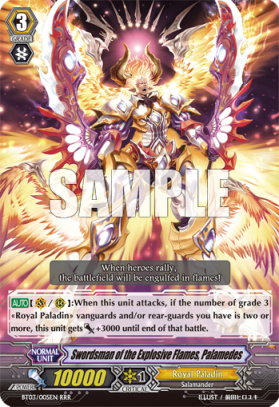
Palamedes. That is a name you should fear. It’s ability is simple, if you have 2 Grade 3’s on the field, it gains 3k on your turn. To clear the first criteria, that ability includes itself, so that’s one down. Hmmm, so what’s the other be? It couldn’t be the Vanguard itself now could it? Actually it is. That means Palamedes is a permanent 13k, including itself and the vanguard for it’s condition. Ya, that’s a goof. It’s not gamebreaking bad, but if look at Bors, then this card, which one is superior? (Note: Bors is not Aizen). No Counterblast or other requirements. Put this behind a 7k, 8k or 9k and it swings for magic numbers. Keep it alone, and it can rip apart 8k units and with a trigger it always needs 10000 Shield. Every other card has units that gain 2000 if you attack a vanguard or is boosted, but this card gains 3000 for doing jack squat. Personally I think that this card, not Barcgal, should have been banned. This card was truly created in the heat of passion.
The other brethren of Palamedes? This units unfortunately do not count them selves, so you do need another Grade 3 to use effectively. And you will have fewer Grade 3’s as your opponent will run all over Palamedes and whatever else you got after you bring even one of these cards out. And after they do, they are rubbish 8k and 6k.
The Galahad line is bad, really bad, and here are the lame reasons why he should be used: It is the ONLY 11k Vanguard the Royal Paladins have, it stacks and it fuels SSD. Let me address all these concerns one by one. It is ONLY 11k if you have all the pieces, missing one and your sitting with a 9k. Unlike a Tsukuyomi line, you can’t fix it. Secondly you don’t need to stack and as flexible as RP can be, reaching a stack is quite difficult without access to consistent drawing and soulcharging. Plus, using a search and call(what RP’s are made for) will ruin the stack. And fueling SSD is nothing. You can get by with Pongal and Stardust. Lastly, the pieces of the Galahad chain is unusable after you finish your chain so even after all that, you now have nothing good to put beside. RP’s already have a full lineup and it does not need some situational crap to cram inside. And one more thing, how are you going to get that sixth soul without being stupid? Yes, 11k is a good defensive number but sadly, it’s wasted on a stupid mach rider. (And you have Palamedes. Have I mentioned its OP?)
However, the Galahad line is a very different variation from Royal Paladin. Although it is not as useful as the Cosmic Paladins, Acceleration Knights represents a new branch for those who want a cheaper RP deck.
EB03
Knight of the White Dragon, Pendragon has his own little article. Marhaus is completely overshadowed by Palamedes and we have another vanilla interceptor (Gallatin still is better as you can get it from a trial deck)
BT05
Royal Paladins unleash brutality with an alliance to the dark side, taking its game to a whole new level.
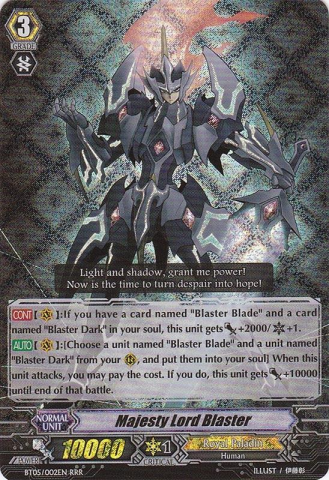
Although it isn’t a crossride in the normal sense, Majesty Lord Blaster qualifies as one with its possible 12k base. It deviates 1000 base power from the other crossrides to increase the chances of getting that base, along with a faster set-up time. To get the maximum chance maximize all the numbers, run 4 BB , BD & MLB. I have no clue why one would run less then 4 MLB, even if Wingal Brave flips every game. Since MLB doesn’t need a ride over, it is perfectly acceptable to skip a turn of riding or ride over Gancelot without repercussions. I say Gancelot because there is a better chance to pull BB with him, and since BB is one of the pieces every bit counts. Plus, BB is the god of retirement, which helps counter the field minus from MLB’s skill.
Now on to its skill. It is litteraly the sum of everything RP has tries to do in its first four sets. Crit and Power. Don’t believe me? Trial Deck 1 has Gancelot, BT03 has Galahad, and BT05 is MLB. On the power side, there are no non-promo grade 3 RP that do not gain power of some sort**. In fact, power and crit is the ONLY source of pressure by Royals, so MLB decided to perfect this system nicely. Although the initial power jump with BB and BD resembles royals, it recieves a lingering crit and power boost that is a perfect cinch. A permentant 2 critical unit is almost as threathening as DOTE’s persona blast, the difference being that an opponent can let it through once. Regardless, having a stacked crit gives MLB the advantage over all other Royal’s even without its crossride defence.
**Screw you Gigantic Charger
And then we get a pair of cards that will reappear for every archetype to come. Knight of Friendship Kay and Knight of Loyalty Bedivere should be run over Starcall Trumpeter for the sole reason of power. Yes, Starcall does extend the piece search but it loses out on its 8k (Gancelot is 9k, which makes all the difference in the crossride meta). Nothing is particularly glaring about it, and is fine outside the meta, but it is just out of place. (Don’t worry, Blaster Blade will eat all those counterblasts easily)
The best RP deck you can make: Majestic Royal Lord Paladin Blaster.
EB01
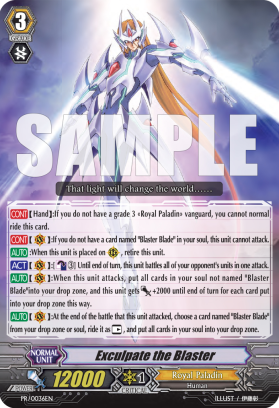
If ten stagnated lines of scrunched text isn’t enough to explain how hyperbolic Exculpate the Blaster is, I’m afraid you have lost your touch with humanity. Since not having a full field is horrible, Exculpate will almost always blow up the entire field getting a +5 out of it. But wait, The ride over the previous grade 3 is (-1), and to wupe the field a cost of CB3 (-2) must be paid, and the opponent is either going to abuse BB’s 9k (-1) or another grade 3 is riden(-1) next turn to migate that. Whew.
So in total, Exculpate lingers between a +2 to a +3 depending on how easily the opponent can abuse it. That’s a fairly brilliant device, though it leaves BB very suspectable to a counterattack. It is not necessary for an opponent to hit magic numbers, but rather to just reach the bare minimum. Hopefully, there is only 1 or 2 teched in, but that means it is most likely going to appear nearer to the endgame. At this point, there isn’t much to guard with if the opponent survives the turn. Granted, the opponent will have fewer cards in reserve and it is likely they can not replace the field. What they do have is going to be placed for an ultimate counter-gambit, hopefully sealing the deal before there is a chance to solidify with another ride.
The largest blow to Excupulate is not its effect but rather the necessary piece to create it. The loss of Barkgal is bad news, as it is the only confirmed way to assure BB in the soul before the ace ride. Without Barkgal, there is the option of Gancelot, but that means ripping apart the ability to secure a respectable grade 3 ride. Interestingly, it can be placed inside an MLB deck, as brave could fish it out. I find more use when this card is ridden over Soul Saver Dragon, not for the grade 3 but for the fact that Pongal is a nice searcher for it. Since its a gambler card by nature, and it has terrible mini-text, I don’t recommend it, but it is not a particularly bad card to mess around with.
Banned or not Double Butterfly gets a nice option for its decklists.
BT10
In the lore, it is said that the Jewel Knights was established before BB, but it took 10 sets before they decided to appear. (I know they had to put on makeup, but still). How now! The pretty ladies have arrived!

Wow. The Jewel Knights are non-staple guild cards. Unfortunately, they are WORSE then the staples. Even though the conditions for Sybill and Sherrie is easy, other guild cards are so much easier it makes this condition a pain to acquire. The royals this set also lack definite power boosts and the ability to attack for high numbers (the 20/21 lines RP is so accustomed to), it is absolutely vannila mayhem. Finally, the initial support is stagnated, being the smallest of the new archetypes and not even capable of completing a full set.
Leading Jewel Knight, Salome == mini-MLB
Okay, making a comparison to MLB is unfair, so let’s view it against all the other power/crit royals. Running full Jewel Knights will get her effect often enough to get the boosts consistently. This means she has a lingering CRIT so the opponent must want to guard the vanguard. Although I ridiculed the Jewel Knights for hampered power like Royal Paladin, forcing the opponent to guard the vanguard every turn is a bonus for Jewel Knights. As long as it can maintain 16k columns throughout the game (which it obviously can), Salome can chip away the opponents cards after a few turns. That is everything positive I can say about her. All of these positives only work in the endgame (locked with Limit Break), and at this point the opponent usually has enough cards stowed away anyhow. That one thing means that a Salome will find itself hitting 16k full row but hammered with 20/21k on the flip side. If it did not need a Limit Break it would certianly be more viable.
The second skill is ACT. That’s amazing. It means that, without any other counterblasts used during the game 2 units can be pulled from nowhere. Attackers, Boosters, Grade 3’s, Grade 0’s, anything Jewel Knight is ready for battle. It has the quality of the original Alfred with more flexibility enabling Salome to pull back after something like a Vermillion Thunderbolt. I would certianly allow a trade and make this ACT restricted to Limit Break and the other CONT free from it, but warenteed it is not my decision to make. Since Grade 2 Jewel Knight’s happen to either have or do not have enough power, one can intercept very quickly and replace it with either a 12k attacker or an 11k Grade 3.
And 11k this Jewel Knight is. To prevent royal abusion of 10k vanguard, Pure Heart Jewel Knight, Ashley covers up that weakness until its time to lay down the pressure. She looks and is really boring. 1 Crit, 10000POWER. No pizazz or anything. But defense is defence, making it a nice addition to Royal Paladin.
I’ve guiltly edited Soul Paladins for a different playstyle. They are very good at producing full 21|21|21 columns without letup, which is better then mosts decks even at Limit Break.
DS01
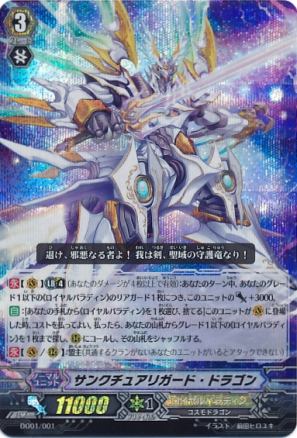
With a Popular Actor on the cover,the special set amply named DS brings a couple of new pals to the fray:
Sanctuary Guard Dragon outclasses Garmore in the sense that Palamedes outclasses Bors. It pulls any Grade 1 rather then a specific one, and gets 3000 per instead of Garmore’s 1000. Not to mention, it has an 11k base.
Sanctuary can go the distance and become one of the most damaging unit in the game, shooting up to 46000 POWER with a Break Ride from Ashley. This is most likely to be perfect guarded, but a nice number to touch nonetheless. In a more down to earth fashion, Sanctuary can fill the bottom row with either Marron/Snowgal for 8k abuse or Toypugal for 9k abuse. It makes one of the most consistent back rows ever, but there is a small problem. Garmore is litteraly repeating the same stragety, so it makes Sancturary try to fit into something that was already self-sustainable. Why it feels the need to fill the same niche (interspecific competition) is unbeknownst to me.
Only two Jewel Knights are featured in this set, but they are able to complete the holes missing in a pure deck. I wouldn’t run Olwen (the Grade 2) since it makes too many 8ks. Without Marron, the best plan would be to sacrifice targets to enhance damage output with either Gallatin or Lamorak (A couple of other grade 2’s come to mind, but this is the most consistent)
Rendgal. Everyone wants a royal 10k booster, and now they have one. For one turn. Akane, Alfred, Constance AND Sanctuary can all fetch it, but it costs an agonizating amount of counterblasts. It has some interesting taste like Jumping Jill, but since every call is quality over quantity, Rendgal just can’t provide an adequate boost to compensate, although being 7k would make its presence softened. (See, this is a card GP’s would like to have). Unless Royal Paladins develop a whole new playstyle, Rendgal is just too situational to be put into any deck.
I’ve neglected Garmore until now mainly because I forgotten it existed, but also because this and Sanctuary are correlated in the Royal Fangs of Light build. And since Jewel Knights are finally pieced together, a deck is ready to go.
Decks Matchups
Angel Feathers – Angel Feathers like to live for a long time, so you need to jump on them and beat them. Go fast with this one.
Aqua Force – Blaster Blade is a perfect counter to the back row swapping units, but a poor defense will leave you vulnerable to nearly every Aquaforce swapper. It is a great matchup.
Genesis – Use your consistent columns to remove Gensis’ advantages. They’ll find that extra plusses can’t keep up with so much power.
Megacolony – Royal Paladin has a good offense and can readily bring forth more units
Nubatama – It is kind of upsetting when they keep targeting rearguards, they can get effects off with that. All your costly high-quality advantage is removed with chipping cheap pressure. It isn’t a hard game to win though, if you concentrate all attacks up front. Blaster Blade can also remove key Nubatama units without resorting to attacking it.
Royal Paladin – Mirror matchup.
Kagero – Here is a hard fought battle, as Kagero have the slight edge here. Being able to retire without attacking, it can potentially remove RP’s greatest strength, without losing attacks on the vanguard that other clans have to resort to. But it isn’t devestating, because unlike other clans you don’t lose as much as other clans do, being able to bring out free units.
Megacolony – replace units and continue pressure.
Nova Grapplers – Too much standing might ruin your field presence.
Tachikaze – Tachikaze aims your VG, and you aim for theirs. Advantage for you as your counterblasts are better.
Oracle Think Tank – OTT have big shield, but if you commit a lot to early pressure they can give out much easier then you might expect.
Dark Irregular – Amon can ruin Royal Paladins, but they have bad hand management. Ironic as it is, execute similar to OTT and win. Meaty vanguard attacks can transform into a good counter attack.
Spike Brothers – I believe patience is a virtue here. Keep striking down their attackers if they have any, and hit the vanguard otherwise. Note that if you don’t have enough to survive their limit break, then don’t attack them. Pay close attention to the soul count, and once you hit a strong punch keep slamming them.
Pale Moon – An assortment of circus tricks won’t put down warriors of steel.
Narukami – Watch out for Vermillion. That thing can blow up your front. So to prepare bring out things like Alfred and Gallatin in Rearguard, swing in and replace them with your real units.
Gold Paladin – Aichi’s new favourite. They have many of Royal Paladin’s characteristics, but instead of calling specific units they sprawl random units everywhere. Attack the vanguard, unless there is a power pressure unit out on the field.
Granblue – Here is another endgame deck, and as always, hit them hard in the early game.
To beat Royal Paladins, you need to be able to pick out a few of their Rearguards to ruin the field, but not to concentrate on them too much as they can pump everything to the vanguard as well.
Conclusion
As you can see, if the opponent plays the endgame, go for the rush. Or if they work better that way, conserve your hand. Royal Paladin’s are great at picking out other clans weaknesses without much of their own. Consistency, Power and Crit are are their best friends.
